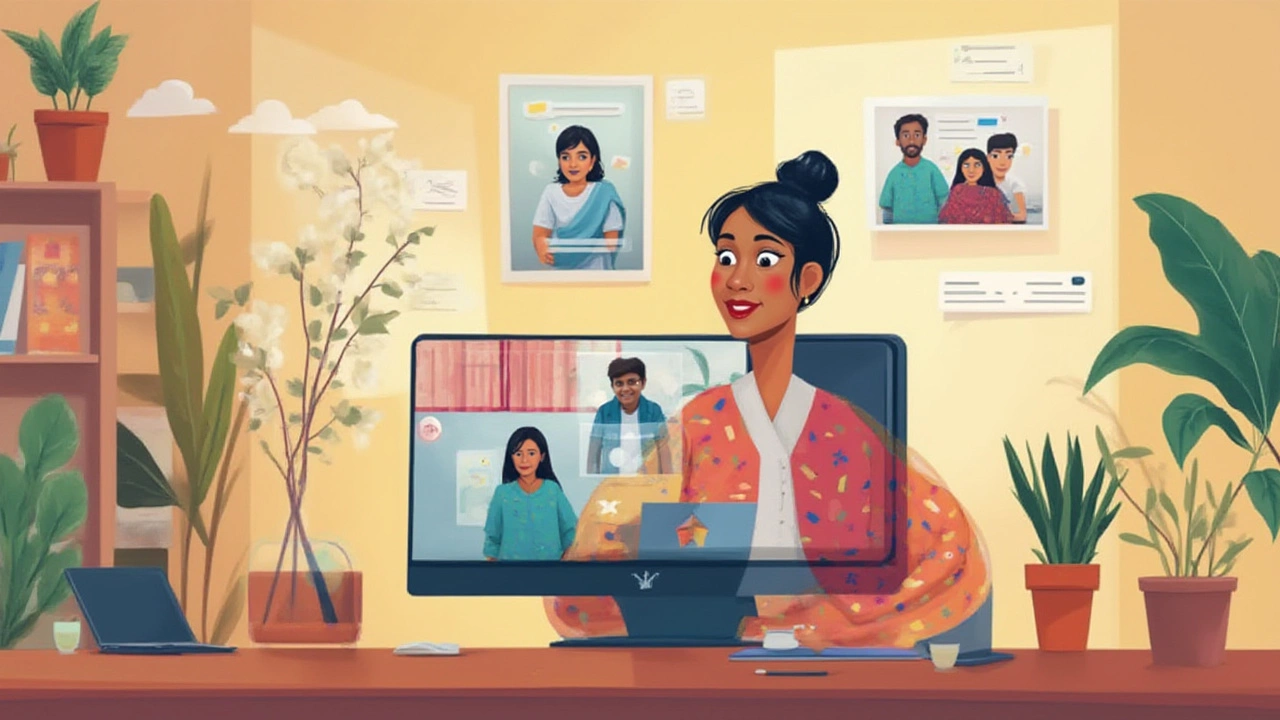
There’s nothing quite like mastering something new without leaving your kitchen table. Flash back to when the world hit pause in 2020—remember all those folks who suddenly switched from crowded classrooms to learning with just a laptop and a spot of Wi-Fi? That’s pure eLearning power in action. But eLearning isn’t just digital worksheets or video calls; it’s a heady mix of interactivity, tech, and creativity, shaking up education everywhere, from Cape Town to Calgary. So what’s a clear example of eLearning? Picture something both exciting and practical. But before you jump to assumptions about endless Zoom meetings (yawn), let's decode what really goes on under the hood.
What Makes eLearning Different from Regular Learning?
First off, eLearning has exploded far beyond clunky PowerPoint slides. It's about interactive platforms packed with animated lessons, quizzes that give instant feedback, games that let you try until you get it right, and collaborations with people you’ve never met—sometimes halfway across the globe. Imagine my neighbor Lerato in Cape Town, who learned Japanese online by speaking with real people in Tokyo, all before making her morning coffee. That’s the kind of global classroom we’re talking about. The best part? eLearning lets you learn at your own pace, whether you’re an early bird or a midnight owl. Pause. Rewind. Repeat. Try that in a live lecture.
Now, one of the biggest myths is that eLearning always means solitary study. Not true! Strong platforms today focus as much on human connection as they do on content. Take the language app Duolingo. It’s built for solo users but thrives on a mix of social progress bars, group challenges, and chatbots for practice. Or consider a virtual classroom like those on Coursera and Udemy. They feature video lectures—but also real discussion boards, peer feedback, and the kind of gamified rewards that keep learners coming back. The magic of eLearning is its adaptability, catering to schoolkids, busy parents, corporate teams, and even the grey-haired wisdom seekers who refuse to slow down.
Let’s anchor this with hard numbers. In 2023, a report by Statista showed that more than 92% of higher education institutions worldwide were using at least one eLearning platform for course delivery. And South Africa? We saw over 45% of university students accessing their core curriculum via online portals. Here’s how that looks:
| Region | eLearning Adoption Rate |
|---|---|
| Global | 92% |
| South Africa | 45% |
| USA | 98% |
| Europe | 88% |
| Asia | 71% |
There’s another crucial thing to recognize—eLearning can be simple or wildly advanced. A class in Python coding on edX can feel totally different from an online biology lab that uses simulations so real, you half-expect to need safety goggles. What links all these? A personalized journey. The tech remembers where you left off, nudges you along when you stall, and hands you a digital badge when you finally ace that tough topic.
As Professor Angela Duckworth from the University of Pennsylvania put it,
“The beauty of eLearning is that it allows learners to fail safely, try again instantly, and feel the joy of small wins — which is exactly how motivation grows.”

A Real Example: The Virtual Science Classroom
Okay, enough hype—let’s check out a specific eLearning setup and see all these buzzwords at work. Push aside your mental image of boring text and think instead about a simulated science lab. For instance, Labster is an online platform used by universities worldwide, including the University of Cape Town, offering interactive virtual science labs. Instead of dissecting frogs in a real lab, students interact with realistic 3D models, manipulate virtual equipment, and run experiments in a completely safe (and much cleaner) online space.
This isn’t just “watch and click” learning. Labster lets users design experiments, predict results, and see instant consequences for mistakes—no explosions, just a quick do-over. Imagine growing bacteria in a digital petri dish; if you mess up, you reset rather than starting from scratch or waiting days for the culture to grow. Each lesson ends with quizzes that both challenge and refresh understanding, with scores and feedback delivered instantly. For students who dread public mistakes, this is freedom. And for universities? It saves on time, costs, and supplies while ensuring every student gets the exact same high-quality experience.
The ripple effects go beyond “fun with gadgets.” Students using Labster for a full semester showed a 76% improvement in practical science knowledge, compared to traditional lecture-based classes, according to a 2022 independent study published in the Journal of Science Education and Technology. These students are not just reading theory but building real-world troubleshooting and decision-making skills—a critical edge whether they’re heading for medical school or the job market.
It’s not just big universities cashing in, either. Loads of high schools in South Africa, especially in rural areas where budgets are tight and lab equipment is scarce, have adopted these virtual labs to give students the chance to experience science hands-on. Suddenly, having no Bunsen burners or beakers doesn’t mean missing out on the magic of chemistry or biology. Teachers find it handy because virtual labs are always available—there’s no scheduling or clean-up, and mistakes aren’t costly. More importantly, students who used to feel intimidated by labs find it easier to engage and try things they’d never risk in a real setting.
Let’s break down a typical lesson flow:
- Login through a secure portal (can be done from home or school, on any device)
- Review learning objectives and safety protocols (pop quizzes test this knowledge up front)
- Step into the virtual lab (guided by on-screen avatars and hints when stuck)
- Design and run an experiment (select chemical concentrations, measure reactions, examine results)
- Receive instant analysis (graphs, feedback, and suggestions for improvement)
- Finish with a summary quiz (earn badges, certificates, and share scores on class leaderboard)
No more scribbling messy notes on the back of your hand—every step is logged and saved, so students can revisit their process later. Teachers get dashboards showing everyone’s progress, spotting who might need extra help and congratulating those who zoom ahead.

The Nuts and Bolts: How to Get the Most From eLearning
Maybe you’ve tried eLearning and bounced off after a couple of days, bored or overwhelmed. Don’t worry, it’s more common than you think. Getting the most out of these platforms means using a few smart tips—learned the hard way by lots of us.
- Set clear small goals. Finishing a chapter is less daunting than “finish the whole course.” Bite-sized targets keep you moving.
- Get social. Jump into discussion forums or class chat. You’ll find out you’re not alone with your struggles—and sharing is a quick way to cement what you’ve learned.
- Mix it up. One big advantage of eLearning is variety. Watch a video, tackle a quiz, then try out a simulation. This prevents burnout.
- Use the data. Most platforms give you detailed breakdowns: time spent, quiz scores, topics where you struggled. Don’t ignore these—they show you where to focus for best results.
- Keep it fun. Gamification works. Collect badges, compete against your friends, or try to break your own streak. Reward yourself for staying consistent.
- Don’t be shy to ask for help. Whether it’s the online support team or just a message to your teacher, getting feedback is way easier when everyone is just a click away.
The tech itself is getting smarter. A good eLearning platform adapts to suit your pace, repeating stuff you find tough and moving quickly through what you’ve mastered. That kind of personalization was impossible in crowded classrooms. For those who have specific learning needs, there are accessibility features like voice-to-text conversion, high contrast displays, or text enlargement—so no one gets left behind. Don’t forget the mobile side of things. Nearly 65% of all eLearning access in Africa happens on smartphones, not big screens. The best platforms are designed for tiny screens and dodgy data connections, making sure you can keep learning whether you’re on the bus or at the beach.
But is eLearning just a gadget fest? Not at all. It works when it feels human—adaptable, forgiving, and focused on real growth instead of just ticking boxes. Cape Town’s own University of the Western Cape reports a jump in engagement rates when switching to blended learning—mixing face-to-face workshops and online elements—showing that digital doesn’t have to mean distant.
Stepping into eLearning is simply stepping into a bigger world—a world full of stories, instant feedback, and more chances to try again. No whiteboards required. Love it or hate it, digital learning isn’t going anywhere. And if you’re looking for an example to wow someone, pull up a virtual science lab, a language duel on your phone, or a live coding meetup that’s half online and half real life. The combination changes the game, every single time.





